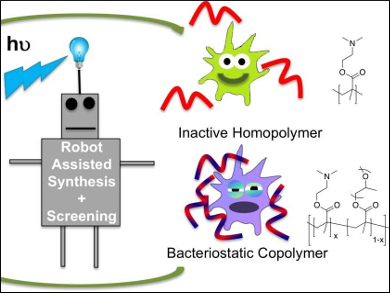Antimicrobial resistance is a global healthcare threat. New antibiotics are urgently needed. While traditional antibiotics target specific cellular pathways, cationic antimicrobial peptides (CAMPs) can directly disrupt bacterial cell membranes. Cationic polymers could mimic CAMP function. However, discovering the most active polymers is a challenge due to the vast range of potential polymer building blocks.
Polymer synthesis normally requires sealed, oxygen-free vials, which makes the screening of large numbers of polymers cumbersome and slow. Matthew Gibson, University of Warwick, UK, and colleagues have used “open air” photopolymerizations to overcome this limiting step. The team used 2‐cyano‐2‐propyl dodecylthiocarbonate as a polymerization agent, together with triethanolamine (TEOA) to degas the solvent, dimethyl sulfoxide (DMSO), in situ. This approach enables the polymerization reactions to proceed in air under a blue LED light.
Using open well plates instead of oxygen-free vials allowed the researchers to automate the polymer synthesis with a liquid handling robot. With this high-throughput robotics approach, they screened a library of polymers for antimicrobial activity. They discovered new copolymers with a surprisingly enhanced antimicrobial activity. According to the researchers, such a material would not have been identified by using conventional screening methods.
- Photochemical “In-Air” Combinatorial Discovery of Antimicrobial Co-polymers,
Sarah-Jane Richards, Adam Jones, Ruben M. F. Tomás, Matthew I. Gibson,
Chem. Eur. J. 2018.
https://doi.org/10.1002/chem.201802594




